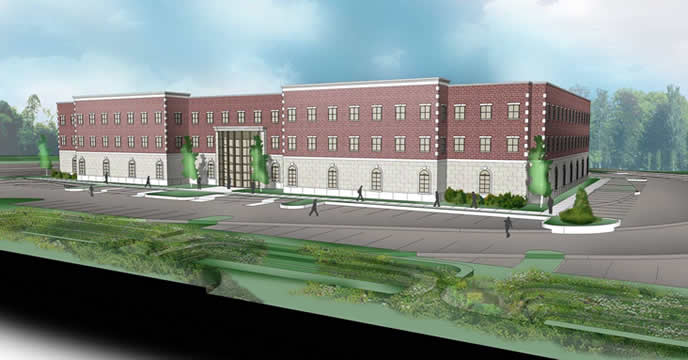User Note: While great efforts have been taken to provide accurate and complete information on the pages of CPEP, please be aware that the information contained herewith is considered a work-in-progress for this thesis project. Modifications and changes related to the original building designs and construction methodologies for this senior thesis project are solely the interpretation of Eric Foster. Changes and discrepancies in no way imply that the original design contained errors or was flawed. Differing assumptions, code references, requirements, and methodologies have been incorporated into this thesis project; therefore, investigation results may vary from the original design. |
|
 |

| |
BUILDING STATISTICS
~ Part 1 ~

General Building Data
Crocker West Building
State College, Pa
‘Classified’
- Occupancy/Function Types (Type of Building):
Group B Occupancy
Type 2B Building Construction
- Size (Total Square Feet):
Approx. 120,000 sf
- Stories Above Ground/Total Levels:
3 Stories A.F.G. / 3 Total Levels (47’ A.F.G.)
- Primary Project Team:
- Owner/Structural Engineer:
Civilsmith Engineering, Inc.
2160 Sandy Drive, Suite C
State College, Pa 16803
(814) 867-9150
CMT Laboratories, Inc.
2380 Commercial Blvd.
State College, Pa 16801
(814) 231-8845
Michael L. Norris & Associates, Inc.
2212 N. Atherton St.
State College, Pa 16803
(814) 867-3823
Evanko – Renwick Engineering
2212 N. Atherton St.
State College, Pa 16803
(814) 234-3442
Sponaugle Construction Services
2134 Sandy Drive, Suite 10
State College, Pa 16803
(814) 861-3592
- Architectural Consultant:
Robert A. Lack, AIA
Architecture and Design, Inc.
230 Market Street
Lewisburg, Pa 17837
(570) 524-2300
- LEED Project Administrator:
Green Collar Consultants, Inc.
1024 Saxton Drive
State College, Pa 16801
(814) 880-3505
Start ~ Feb. 2009 to Finish ~ Dec. 2009
- Cost/Project Delivery Method:
Approx. $18 Million / Design-Bid-Build

Architecture
- Architecture:
- The Crocker West Building will be used as a highly classified research facility, specializing in the development and testing of underwater weapons for the U.S. Department of Defense. For this reason, the façade of the structure only contains a minimal amount of repetitious windows, most of which will be tinted for security purposes. The architectural pre-cast concrete panels may be designed in a variety of ways to create the authentic look the owner desires. Although the veneer will look like real brick and stone, individual panels will be designed with either a brick or stone veneer in-lay; where a mold resembling the face of a brick or stone are laid in place prior to casting the panel. This allows for a controlled veneer and joint pattern. Also, the panels will be cast using specific concrete colors and finished using an assortment of sand-blasts to provide a clean, natural looking façade.
- Major National Model Codes Used:
- Zoning:
- Follows zoning codes set forth by Ferguson Township
(Located in Centre County, Pennsylvania)
- Building Envelope:
- A majority of the Crocker West building envelope is composed of pre-cast concrete systems. Both the core roof and floor systems are made up of 8” and 10” hollow-core, pre-stressed pre-cast planks respectively, with a typical 2” topping at each floor. These hollow-core planks are supported by pre-cast IT-beams of various depths connected to pre-cast columns cast monolithically with corbels for bearing. The wall system is to be constructed of 9 ½” and 12 ½” thick, insulated pre-cast panels. These wall panels are detailed with 2 ½ “ rigid insulation sandwiched between two concrete panels, a brick/stone veneer in-lay cast directly into each panel, and four foot wide, tinted Pella windows ranging from 5 to 8 feet tall were applicable. Each member is erected individually and secured to other members using pre-cast connection practices. The foundation system is made up of cast-in-place (CIP) strip and pad footings; ultimately the only non-precast structural component on the project. Additionally, 24” deep, pre-cast double-tees will be used for the main warehouse roof system, and a 6” slab-on-grade floor system will be placed at ground level. The finished roofing systems will consist of a TPO roofing membrane, 4” rigid polyisocyanurate insulation, and 60 mil EPDM roofing system.
~ Part 2 ~
Primary Engineering Systems
- Structural:
- The structural system for the Crocker West building consists of specially designed precast (pc) shear-walls, pc-columns, pc-wall panels, and prestressed pc-hollow-core plank and beams. The lateral loads will collectively be distributed to one of the many shear-walls placed throughout the layout. The pc-columns used will be 24”x24” square and will be cast monolithically with specially designed corbels for beam bearing. The floor systems will be constructed using prestressed precast inverted-tee beams and prestressed precast hollow-core plank. Each IT beam is cast with ledges used for plank bearing. The hollow-core plank sizes range start at 12” on the second floor, 10” on the third floor, and 8” on the roof. The IT beam depths are 28” at the 2nd floor, 20” at the 3rd floor, and 18” at the roof with a standard overall width of 36”. Wall panels making up the façade are composed of 12 ½” and 9 ½” thick insulated precast panels. The insulated system consists of 2 ½” of rigid insulation sandwiched between two individual precast panels ranging from 2 ½” to 7 ½” thick. Finally the foundation system will be the only non-precast element. Pad footings will be placed at the columns and will range from 12’ square to 14’-5 square. Around the perimeter, 3’-3 to 6’-6 wide strip footings will be used. Standard depth of all footings is 24”. Stair-tower footings are 25’-6 long by 12’ wide and are also two foot thick. A six inch thick slab-on-grade reinforced with W4.0 x W4.0 WWF will complete the foundation system(s) and will be used as the ground floor level of the building.
- Mechanical:
- Parapets located at the top of the wall panels will act as cover for the HVAC roof top units (RTU). The mechanical system for this structure is still in design phase and can not be described at this time. Upon finalization, this section will be updated.
- Electrical/Lighting:
- Crocker West will have two separate services into the building. The first service will be 277/480V, 60 hz, 3-phase, 4000 amp, and the second will be a 120/280V, 60 hz, 3-phase, 2000 amp service. Both of these entrances will be directed to a switchgear that will distribute the power to panel boards located throughout the building. Provisions for an emergency generator connection will be made at the rear of the facility.
- The first floor of the structure will consist mainly of 8’ fluorescent strip lights in the required lab space, and a few areas with 2’x4’ fluorescent light fixtures. The second and third floor lighting plans will be constructed using mainly 2’x4’ fluorescent fixtures, with a few areas on the second floor containing strip fixtures. Exterior sconce lights are to be placed around the perimeter of the building at the walkways.
- Construction:
- The construction of Crocker West is slated to begin in February 2009 and is scheduled for completion by December 2009. Several different construction managers will head the operation during the different phases of construction, as the project will be delivered by a design-bid-build method. The use of Architectural Precast Concrete helps achieve a considerably short project schedule with its speed of erection and ability to be cast and erected in many types of weather.
Engineering Support Systems
- Fire Protection:
- Architectural precast concrete is non-combustible with inherent fire-resistant capability, creating a safe envelope. It also eliminates the need and cost of additional fireproofing.
- Interior Transportation:
- Crocker West is equipped with four separate stair-towers located in the vicinity of each corner of the building. A monumental stair positioned in the lobby area will serve the ground floor and second floor levels. In addition, two 3,500 lb. passenger elevators are also situated near the lobby for pedestrian traffic. One 10,000 lb. freight/passenger elevator was placed in the rear, adjacent to the warehouse area.
- Special Systems:
- A highly extensive security system will be implemented into this project after the closeout. Due to the government research, the occupant of the structure is withholding this information for security purposes. Special security clearances will be mandated as necessary.
- An accessible green roof will cover a portion of the warehouse roof section. The green roof will aide in obtaining LEED Certification and collecting grey water which will be diverted to an onsite cistern. The grey water recycling cistern will be 12’ wide x 12’ deep x 130 feet long and will capture all roof drainage for reuse.
|
The Capstone Project Electronic Portfolio (CPEP) is a web-based project and information center. It contains material produced for a year long Senior Thesis class. Its purose, in addition to providing central storage of individual assignments, is to foster communication and collaboration between student, faculty consultant, course instructors, and industry consultants. This website is dedicated to the research and analysis conducted via guidelines provided by the Department of Architectural Engineering. For an explanation of this capstone design course and its requirements...click here. |
|
|



